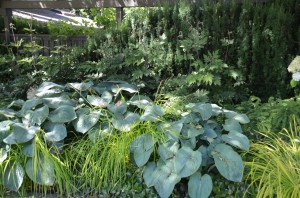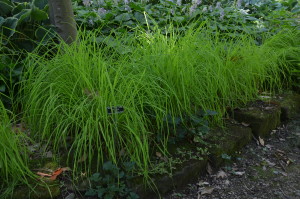Bowles’ golden sedge (Carex elata ‘Aurea’) is an easy to grow sedge (USDA hardiness zones 5-8). Golden sedge was introduced by English plantsman and garden writer E.A. Bowles who discovered it growing in eastern England.
Bowles’ Golden sedge grows 1 ½ to nearly 3 feet high (in flower) and 2-3 feet wide. It features bright lemon- yellow leaves with dark green margins. Its fine-textured foliage turns lime-green in heavy shade. In late May (in zone 6), tiny brownish-colored flowers appear, but are mostly insignificant. You may opt to clip them off and put all energy into growing the plant.
Bowles’ Golden can be utilized for erosion control along stream banks. It freely naturalizes and eventually may dominate its wet surroundings. Clumps 3 years and older can be easily divided and/or transplanted in late winter or early spring before new growth begins. Fertilize the planting with a slow release organic fertilizer in early spring or feed with a water soluble product such as Miracle-Gro™ or Peters™.
Grow it in a moist loamy acidic soil and in partial shade. Bowles’ Golden will tolerate moderately dry soils in a shady garden spot. Plant it on the edge of a pond or water garden submersed in 1-2 inches of water. It can be planted in full sun under frequent irrigation where its golden color will shine. Golden sedge may also be planted in containers among other moisture-loving plants. You may substitute with other gold leaf favorites like golden sweet flag (Acorus gramineus ‘Ogon’) or Aureola hakone grass (Hakonechloa macra ‘Aureola’).
Golden sedge has no serious pests and is deer resistant. The foliage on established clumps may brown or grow shorter during temporary dry spells and recovers as soil moisture is more plentiful.



 Posted in
Posted in 
